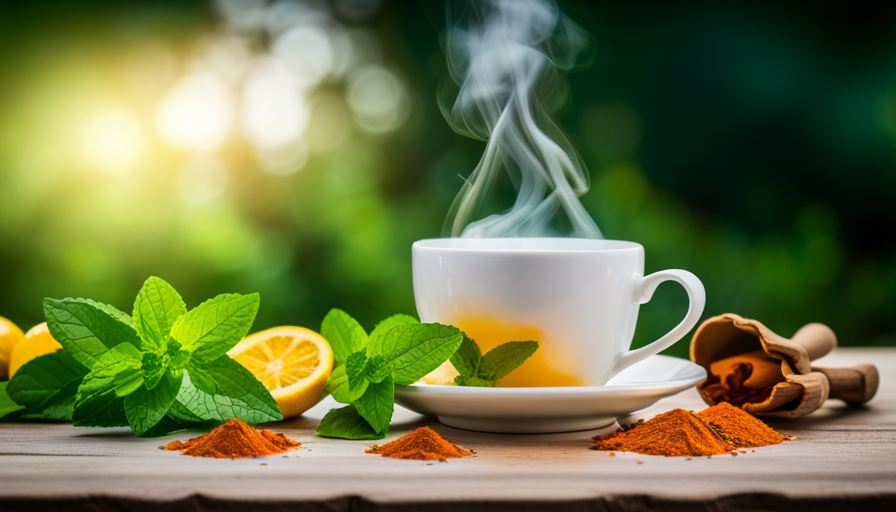Did you know that turmeric has been used for centuries in traditional medicine for its healing properties? It’s true! In fact, turmeric contains a compound called curcumin, which has been found to have anti-inflammatory and antioxidant effects. But when it comes to turmeric, is fresh better for you than dried?
According to a study published in the Journal of Food Science, fresh turmeric contains higher levels of curcumin compared to dried turmeric. This means that consuming fresh turmeric may provide you with more of the health benefits associated with curcumin.
In this article, we will explore the nutritional content, flavor profile, and medicinal properties of both fresh and dried turmeric to help you decide which one is right for you.
So, whether you’re looking to add flavor to your dishes or boost your overall health, join me as we dive into the world of fresh and dried turmeric.
Key Takeaways
- Fresh turmeric contains higher levels of curcumin compared to dried turmeric.
- Consuming fresh turmeric may provide more health benefits associated with curcumin.
- Fresh turmeric is rich in antioxidants and beneficial compounds for overall health.
- Fresh turmeric has a more intense and pungent flavor compared to dried turmeric.
Nutritional Content of Fresh Turmeric
If you’re looking to boost your nutritional intake, you’ll be pleased to know that fresh turmeric packs a powerful punch when it comes to its nutrient content. This vibrant root isn’t only known for its vibrant orange color and distinct flavor, but it’s also loaded with beneficial compounds that can support overall health.
Fresh turmeric is a versatile ingredient that can be used in a variety of recipes. You can add it to smoothies and juices, incorporate it into curries and stir-fries, or find countless other ways to enjoy this flavorful spice. It can add a bright and earthy flavor to your dishes, while also providing a range of health benefits.
When it comes to storing fresh turmeric, it’s important to keep it in a cool, dry place. You can store it in the refrigerator for up to two weeks, or you can freeze it for longer-term storage. To freeze fresh turmeric, simply peel and chop it into small pieces, then place it in an airtight container or freezer bag.
Now that we’ve explored the nutritional content and storage of fresh turmeric, let’s dive into the next section about the nutritional content of dried turmeric.
Nutritional Content of Dried Turmeric
When using dried turmeric, you may be missing out on some of the essential nutrients that are present in fresh turmeric, similar to how a dried flower loses its vibrant colors and fragrance.
While dried turmeric still retains some of its health benefits, the drying process can cause a loss in certain nutrients. Fresh turmeric contains higher levels of vitamins, such as vitamin C and vitamin E, as well as minerals like potassium and manganese. These nutrients play important roles in supporting our immune system, maintaining healthy skin, and promoting proper heart function.
Although dried turmeric can still provide some health benefits, it is important to consider the cooking methods and storage methods. Cooking methods such as boiling or simmering dried turmeric for a longer period of time can further reduce its nutrient content. Additionally, improper storage of dried turmeric can lead to a faster degradation of its nutrients. It’s best to store dried turmeric in an airtight container in a cool, dark place to preserve its nutritional value.
Transitioning into the subsequent section about the flavor profile of fresh turmeric, it’s worth noting that the fresh form not only offers superior nutrition but also a more vibrant and aromatic taste.
Flavor Profile of Fresh Turmeric
Experience the tantalizing aroma and vibrant taste that bursts forth from each bite of fresh turmeric, adding an invigorating twist to your culinary creations. Using fresh turmeric in cooking not only elevates the flavor of your dishes, but also provides numerous health benefits. Here are some reasons why you should incorporate fresh turmeric into your cooking repertoire:
- Rich in antioxidants: Fresh turmeric contains powerful antioxidants like curcumin, which help protect your body against free radicals and reduce inflammation.
- Boosts immune system: The natural compounds present in fresh turmeric can strengthen your immune system, helping you stay healthy and ward off illnesses.
- Enhances digestion: Fresh turmeric has been used for centuries to aid digestion and improve gut health. Its anti-inflammatory properties can soothe digestive issues and promote a healthy gut.
- Adds vibrant color: The bright yellow-orange hue of fresh turmeric adds a visually appealing touch to your dishes, making them even more enticing.
To store fresh turmeric properly, keep it in the refrigerator in a ziplock bag or an airtight container. It can last for up to two weeks if stored correctly.
Now, let’s explore the flavor profile of dried turmeric and how it compares to its fresh counterpart.
Flavor Profile of Dried Turmeric
Dried turmeric has a distinct flavor profile that is characterized by its intensity and pungency. It has a warm, earthy taste with a slightly bitter undertone.
In terms of culinary uses, dried turmeric is commonly used as a spice in various dishes, such as curries, soups, and stews, to add depth and color. It pairs well with other warm and aromatic spices like cumin, coriander, and ginger, making it a versatile ingredient in many cuisines.
Intensity and Pungency
Fresh turmeric has a more intense and pungent flavor compared to dried turmeric. When it comes to intensity comparison, the fresh root offers a vibrant and bold taste that can be overpowering if used in excess. Its pungency levels are also higher, providing a strong and peppery kick to dishes.
To convey a deeper meaning, consider these factors:
- Fresh turmeric adds a vibrant yellow color to dishes, making them visually appealing.
- Its intense flavor enhances the taste of curries, soups, and stir-fries.
- The pungency of fresh turmeric complements spicy ingredients like ginger and chili.
- It can be grated or juiced to obtain a concentrated form for medicinal purposes.
- Fresh turmeric’s flavor gradually mellows when cooked, offering a nuanced taste.
Transitioning into the next section about culinary uses and pairings, it’s important to explore the versatility of fresh turmeric in various recipes.
Culinary Uses and Pairings
Now that we understand the intensity and pungency of fresh turmeric compared to dried, let’s explore its culinary uses and flavor pairings. Fresh turmeric has a vibrant, earthy flavor that adds depth to dishes. It is commonly used in Indian and Southeast Asian cuisines, where it is added to curries, stir-fries, and rice dishes. It can also be used to make a delicious turmeric paste or added to smoothies for a health boost. When it comes to flavor pairings, fresh turmeric complements ingredients like ginger, garlic, coconut milk, and citrus fruits. The combination of these flavors creates a harmonious balance in dishes. To illustrate the versatility of fresh turmeric, here is a table showcasing some popular culinary uses and flavor pairings:
| Culinary Uses | Flavor Pairings |
|---|---|
| Curries | Ginger |
| Stir-fries | Garlic |
| Rice dishes | Coconut milk |
| Turmeric paste | Citrus fruits |
As we delve into the medicinal properties of fresh turmeric, we will see how its culinary uses contribute to its health benefits.
Medicinal Properties of Fresh Turmeric
Fresh turmeric has impressive medicinal properties, particularly in its anti-inflammatory effects. Studies have shown that the active compound in turmeric, called curcumin, can help reduce inflammation in the body. This may be beneficial for conditions such as arthritis and inflammatory bowel disease. Additionally, fresh turmeric has the potential to support digestive health. It can improve digestion and reduce symptoms such as bloating and gas.
Anti-Inflammatory Effects
To enhance the anti-inflammatory effects, you should consider incorporating dried turmeric into your diet. While fresh turmeric has its own benefits, dried turmeric has been found to be more effective in reducing inflammation. Studies have shown that the active compound in turmeric, called curcumin, has powerful anti-inflammatory properties.
When turmeric is dried, the concentration of curcumin increases, making it a potent ingredient for reducing inflammation in the body.
To emphasize the importance of incorporating dried turmeric into your diet, here are five key points to consider:
- Dried turmeric contains higher levels of curcumin, the compound responsible for its anti-inflammatory benefits.
- Compared to other anti-inflammatory foods, dried turmeric has been found to be more effective in reducing inflammation.
- Adding dried turmeric to dishes such as curries, stir-fries, or smoothies can easily increase your daily intake.
- You can also find dried turmeric in supplement form for a convenient and concentrated dose of curcumin.
- It’s important to note that while dried turmeric is beneficial, it’s always best to consume it as part of a balanced and varied diet.
Incorporating dried turmeric into your diet can not only enhance the anti-inflammatory effects but also potentially provide benefits for digestive health.
Potential Benefits for Digestive Health
Enhancing your digestive health may be as simple as incorporating dried turmeric into your diet. Turmeric has long been used in traditional medicine to treat digestive issues such as indigestion and bloating. Research suggests that turmeric may help improve digestion by increasing the production of digestive enzymes and reducing inflammation in the gut. Additionally, turmeric has been found to have antibacterial properties that can help fight against harmful gut bacteria. However, it’s important to note that there are potential risks associated with consuming turmeric, especially in high doses. Some people may experience stomach upset or allergic reactions. It is recommended to start with a low dosage and gradually increase it if needed. Consulting with a healthcare professional is also advised, especially if you have any existing digestive conditions. Moving on to the next section, dried turmeric also possesses medicinal properties that can benefit overall health.
Medicinal Properties of Dried Turmeric
There’s a noteworthy statistic that highlights the medicinal properties of dried turmeric. It contains a compound called curcumin, which is known for its medicinal benefits and antioxidant properties. Here are five important things to know about the medicinal properties of dried turmeric:
-
Dried turmeric has anti-inflammatory effects, reducing inflammation in the body. This can help alleviate symptoms of chronic conditions like arthritis and inflammatory bowel disease.
-
The antioxidants in dried turmeric protect the body against oxidative stress and damage caused by free radicals. This can potentially reduce the risk of chronic diseases such as heart disease and cancer.
-
Dried turmeric may have pain-relieving properties, making it a natural alternative to non-steroidal anti-inflammatory drugs (NSAIDs) for conditions like joint pain and headaches.
-
Traditionally, dried turmeric has been used to improve digestion and relieve gastrointestinal issues such as bloating and indigestion.
-
Preliminary research suggests that the curcumin in dried turmeric may have neuroprotective effects, potentially helping to prevent or delay the onset of neurodegenerative diseases like Alzheimer’s.
Dried turmeric possesses numerous medicinal properties, including anti-inflammatory, antioxidant, pain-relieving, digestive aid, and potential brain health benefits. These findings highlight the potential advantages of incorporating dried turmeric into your daily routine.
Conclusion: Fresh vs. Dried Turmeric
After exploring the medicinal properties of dried turmeric, it’s time to weigh the pros and cons of fresh versus dried turmeric.
As an individual seeking optimal health, I’m curious to know which form of turmeric is better for me. When comparing the two, it’s evident that fresh turmeric offers unique health benefits that dried turmeric may lack.
Fresh turmeric, often referred to as the golden root, contains a higher concentration of curcumin, the active compound responsible for its medicinal properties. Curcumin is a potent antioxidant and anti-inflammatory agent that’s been linked to various health benefits, including improved brain function, reduced risk of chronic diseases, and enhanced immune system function.
Additionally, fresh turmeric has a vibrant and earthy flavor that can elevate the taste of any dish. It can be easily grated or juiced, making it a versatile ingredient in cooking and beverages.
While dried turmeric still contains curcumin, the drying process may lead to a loss of potency and flavor. However, it’s worth noting that dried turmeric has a longer shelf life and is more readily available than fresh turmeric.
Fresh turmeric undoubtedly offers greater health benefits compared to its dried counterpart. Incorporating fresh turmeric into my daily routine seems like a practical and delicious way to enhance my overall well-being.
Frequently Asked Questions
How can I incorporate fresh turmeric into my cooking?
To incorporate fresh turmeric into my cooking, I can grate it into stir-fries, curries, or soups. It adds a vibrant color and a warm, slightly peppery flavor. Consuming fresh turmeric may have benefits for overall health, including anti-inflammatory and antioxidant properties.
Are there any potential side effects of consuming fresh turmeric?
There are potential side effects of consuming fresh turmeric, such as stomach upset, dizziness, and allergic reactions. It is important to consume it in moderation and not exceed the recommended daily intake.
Can dried turmeric be used as a substitute for fresh turmeric in recipes?
When substituting dried turmeric for fresh in recipes, it’s important to consider that while fresh turmeric offers more health benefits, dried turmeric still provides some benefits and can be a convenient alternative in cooking.
How does the cost of fresh turmeric compare to dried turmeric?
The cost of fresh turmeric is generally higher compared to dried turmeric. However, considering the health benefits it offers, the cost is worth it. Fresh turmeric contains higher levels of beneficial compounds and antioxidants.
Are there any specific storage recommendations for fresh and dried turmeric to maintain their quality?
What are the best ways to store fresh and dried turmeric to maintain their quality? Here are some turmeric storage tips and the benefits of using fresh turmeric in your cooking.
Conclusion
After comparing the nutritional content, flavor profile, and medicinal properties of fresh and dried turmeric, it’s clear that both have their own unique benefits.
While fresh turmeric may contain higher levels of certain nutrients, dried turmeric is more concentrated and can be easier to incorporate into various dishes.
Ultimately, the choice between fresh and dried turmeric depends on personal preference and the specific needs of an individual. Just like choosing between two paths in a forest, both fresh and dried turmeric can lead to a healthier and more flavorful journey.










